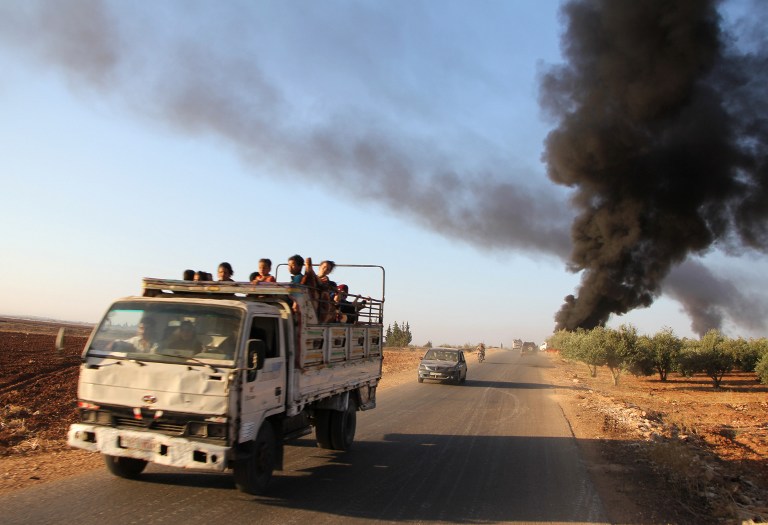
A coalition of rebels and jihadists quickly advanced this week in the province of Hama, in central Syria, which is largely controlled by the regime forces, and has captured a number of towns, according to the Britain-based Syrian Observatory for Human Rights. On August 29 allied insurgent jihadist groups, including the influential Jund al-Aqsa, launched an offensive with the aim of taking Hama airport, where military helicopters take off to knock the enemies of the regime on other fronts. / AFP PHOTO / Omar haj kadour
BEIRUT, Lebanon (AFP) – by Rana Moussaoui
Rebels and jihadists battled pro-government forces in the central Syrian province of Hama Thursday as the country’s UN envoy warned that more people could be forcibly evacuated from towns besieged by the regime.
The Syrian Observatory for Human Rights monitoring group said at least 25 civilians, including children, were killed in government air strikes as fighting raged in Hama, south of the opposition-held Idlib province.
Anti-government groups, which include jihadists and Sunni Islamists, launched an offensive in Hama on Monday aimed at retaking its airport, where regime helicopters fly regular sorties against opposition fighters.
“They are about 10 kilometres (six miles) from the airport” in Hama, Syria’s fourth-largest city, said Observatory director Rami Abdel Rahman, whose group relies on a broad network of sources inside Syria.
The rebels are also likely seeking to ease pressure on opposition fighters in the battleground second city of Aleppo by distracting regime forces ahead of mooted peace talks, which the United Nations is aiming to restart after a “political initiative” this month.
Syria’s UN envoy Staffan de Mistura censured the Syrian government’s “strategy” of forcing inhabitants of Daraya — a rebel-held town near Damascus that endured a four-year siege — and warned other towns were likely to experience the same fate.
De Mistura said there were “indications that after Daraya we may have other Darayas,” adding that “there is clearly a strategy at the moment to move from Daraya” to other besieged areas “in a similar pattern”.
Hundreds of fighters and their families were bused out of Daraya last week, with other civilians transferred to government territory near Damascus for resettlement.
The Syrian army has said it is in complete control of the town, from where roughly 8,000 civilians were still due to be evacuated.
De Mistura pointed to worrying signs around the surrounded towns of Waer and Moadamiyat al-Sham, whose residents make up some of the 590,000 people that the UN says lives under siege in Syria — mostly by government forces.
‘Political initiative’
The Observatory said Thursday that the rebel alliance in Hama seized control of 14 populated areas, mainly in the north of the province, including the towns of Halfaya and Suran.
The alliance also took a military base near the Maardes area, a dozen of kilometres south of Hama city, seizing artillery shells and rockets.
They were also threatening the historic Christian town of Mahrada to the west along the road, which is home to one of the country’s largest power stations.
Hama province is of vital strategic importance to President Bashar al-Assad, separating opposition forces in Idlib from Damascus to the south and the regime’s coastal heartlands to the west.
Hama city has a long history of suppressed uprisings, with major demonstrations in 2011 put down by the government and a brutal purge of Muslim Brotherhood supporters there in 1982 that killed thousands.
Syria’s conflict has killed more than 290,000 people and displaced millions. Successive rounds of peace talks have failed to stem the bloodshed.
De Mistura said he was planning to present “an important political initiative” for Syria even as the prospect of renewed peace negotiations remains dim.
He refused to provide any details on what the political initiative might be, but said he hoped it would help the UN General Assembly “to look the problems in Syria in the eye” when it next meets on September 13.
‘Increased’ cluster bomb use
Syria’s civil war, which started with peaceful anti-government protests more than five years ago, has degenerated into a multi-front conflict and dragged in world powers and forces backed by some neighbouring countries.
Russia has conducted air strikes in support of Assad’s government since September 2015 and on Thursday was accused of significantly upping its use of cluster bombs in Syria.
A coalition of NGOs lead by Human Rights Watch said an annual study had pinpointed increased use of the munitions in Syria, which spray bomblets indiscriminately, and which Russia has repeatedly denied using.
A total of 248 people were killed or injured in Syria by the munitions last year, almost all civilians, the Cluster Munition Monitor report said.
In Aleppo, where rebels and pro-regime forces have fought for over a month to control of the second city’s access points, residents in rebel-held districts faced renewed shortages on Thursday as government fighters fired on the main supply road into their districts.
Markets were empty and fuel was scarce, an AFP correspondent in the city’s opposition-controlled east said.








